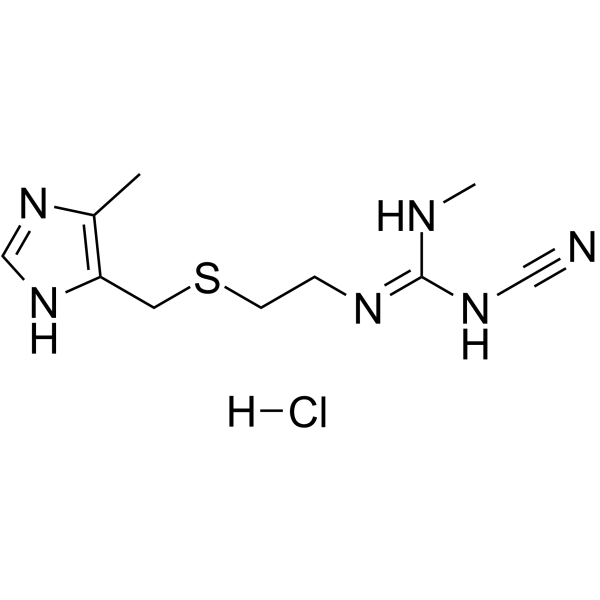Cimetidine hydrochloride

Cimetidine hydrochloride structure
|
Common Name | Cimetidine hydrochloride | ||
|---|---|---|---|---|
| CAS Number | 70059-30-2 | Molecular Weight | 288.80000 | |
| Density | N/A | Boiling Point | 488ºC at 760 mmHg | |
| Molecular Formula | C10H17ClN6S | Melting Point | N/A | |
| MSDS | Chinese USA | Flash Point | 248.9ºC | |
|
Pharmacokinetic study of hydroxypropylmethylcellulose microparticles loaded with cimetidine.
Adv. Clin. Exp. Med. 22(1) , 41-5, (2013) The objective of this study was to assess the pharmacokinetic behavior of floating hydroxypropylmethylcellulose microparticles loaded with cimetidine (FMC) prepared using the non-solvent addition coacervation technique.Based on the physico-chemical characteri... |
|
|
Multiple mechanisms of ligand interaction with the human organic cation transporter, OCT2.
Am. J. Physiol. Renal Physiol. 304(1) , F56-67, (2013) OCT2 is the entry step for organic cation (OC) secretion by renal proximal tubules. Although many drugs inhibit OCT2 activity, neither the mechanistic basis of their inhibition nor their transport status is generally known. Using representatives of several st... |
|
|
Inhibition of human alcohol and aldehyde dehydrogenases by cimetidine and assessment of its effects on ethanol metabolism.
Chem. Biol. Interact. 202(1-3) , 275-82, (2013) Previous studies have reported that cimetidine, an H2-receptor antagonist used to treat gastric and duodenal ulcers, can inhibit alcohol dehydrogenases (ADHs) and ethanol metabolism. Human alcohol dehydrogenases and aldehyde dehydrogenases (ALDHs), the princi... |
|
|
Molecular pharmacological approaches to effects of capsaicinoids and of classical antisecretory drugs on gastric basal acid secretion and on indomethacin-induced gastric mucosal damage in human healthy subjects (mini review).
Curr. Pharm. Des. 19(1) , 84-9, (2013) Actions of various drugs have been tested on the gastric acid basal secretion and on the drug (Indomethacin)- induced gastric mucosal damage; however their physiological and pharmacological mechanisms have not been compared.The effects of capsaicinoids, atrop... |
|
|
Screening of the inhibitory effect of xenobiotics on alcohol metabolism using S9 rat liver fractions.
Toxicol. In Vitro 26(7) , 1177-80, (2012) The purpose of this work was to develop and optimize a simple and suitable method to detect the potential inhibitory effect of drugs and medicines on alcohol dehydrogenase (ADH) activity in order to evaluate the possible interactions between medicines and alc... |
|
|
Evidence for organic cation transporter-mediated metformin transport and 5'-adenosine monophosphate-activated protein kinase activation in rat skeletal muscles.
Metab. Clin. Exp. 64(2) , 296-304, (2015) 5'-Adenosine monophosphate-activated protein kinase (AMPK) is a key molecule of metabolic enhancement in skeletal muscle. We investigated whether metformin (MET) acts directly on skeletal muscle, is transported into skeletal muscle via organic cation transpor... |
|
|
Ulcerogenic and intestinal motility/transit stimulating actions of nevirapine in albino Wistar rats.
J. Physiol. Biochem. 69(3) , 547-57, (2013) The antiretroviral is a non-nucleoside reverse transcriptase inhibitor of human immunodeficiency virus type 1. This study was undertaken to investigate the effect of nevirapine (NVP) administration on gastric acid secretion, pepsin secretion, mucosal secretio... |
|
|
Synergistic and additive effects of cimetidine and levamisole on cellular immune responses to hepatitis B virus DNA vaccine in mice.
Scand. J. Immunol. 77(2) , 84-91, (2013) We and others have previously shown that both cimetidine (CIM) and levamisole (LMS) enhance humoral and cellular responses to DNA vaccines via different mechanisms. In this study, we investigated the synergistic and additive effects of CIM and LMS on the pote... |
|
|
Topical antihistamines display potent anti-inflammatory activity linked in part to enhanced permeability barrier function.
J. Invest. Dermatol. 133(2) , 469-78, (2013) Systemic antagonists of the histamine type 1 and 2 receptors (H1/2r) are widely used as anti-pruritics and central sedatives, but demonstrate only modest anti-inflammatory activity. Because many inflammatory dermatoses result from defects in cutaneous barrier... |
|
|
Improved efficacy of a novel anti-angiogenic drug combination (TL-118) against colorectal-cancer liver metastases; MRI monitoring in mice.
Br. J. Cancer 107(4) , 658-66, (2012) The poor prognosis of patients with colorectal-cancer liver metastases (CRLM) and the insufficiency of available treatments have raised the need for alternative curative strategies. We aimed to assess the therapeutic potential of TL-118, a new anti-angiogenic... |